Coming Soon: A Race to the Bottom

Most know that drug costs are high, but can they also be too low? Paradoxically, increasingly many observers of the generic drugs complex are saying "yes." Tracing the origins of the system that exists today, the authors examine the forces behind the status quo and show what reform may look like.
When we pick up our medications at the pharmacy, most of us do not give much thought to where they were made. If we notice that the pills appear slightly different since the last refill, the doctor will tell us not to worry. Following guidelines from the highest medical authorities, the healthcare professional safely assumes that the drug is essentially the same, regardless of its manufacturer. Under the FDA's current regulation, prescribers and pharmacists are permitted to swap a brand-name medication, whether it be a chemotherapy agent or a routine refill, with a generic version:
In the multi-trillion dollar system of American healthcare, the importance of generic drugs is hard to understate. Beyond providing relief to ballooning government budgets, the uptake of generic drugs has transformed medicine cabinets nationwide, making up over nine-out-10 prescriptions today.
The FDA-approved premise that all generic drugs work the same as their brand-name counterparts hinges on the agency's strict and routine oversight of drug manufacturers. In practice, when a generic manufacturer seeks approval, it must demonstrate that its version delivers approximately the same amount of active ingredient to the bloodstream at roughly the same rate as the original. Crucially, this testing is performed only once, on a small batch, before approval—not on the millions of pills that will eventually reach patients. Thereafter, facility inspections are supposed to be conducted on a routine basis to test for quality.
However, mounting evidence of failures of oversight by the agency, compounded by economic and political forces that sustain a marketplace indifferent to substandard drugs, suggests that a deeper examination of this premise is warranted.
The first major evidence of systemic failures emerged in Katherine Eban’s 2019 book, Bottle of Lies. Her investigation followed industry executive Dinesh Thakur as he unmasked systemic data fraud at Ranbaxy Laboratories, India's largest generic drug manufacturer that was a key supplier to the United States, a country with a high appetite for inexpensive medicine made abroad. The executive felt compelled to blow the whistle out of concerns that low quality manufacturing practices were leading to millions of patients taking dangerously compromised medicines, from common antibiotics to AIDS treatments. Far from an isolated case, Ms. Eban meticulously documented evidence of widespread failures in oversight at the FDA.
This subpar oversight suggests that the assumption that you can freely substitute generic drugs for brand-name counterparts is no longer a given. After the book was released, expectations were high for a reckoning that would usher in reforms to ensure all medicines have been held to the same quality standards before arriving on pharmacy shelves. Despite the book's critical acclaim, the public remains unaware of the disturbing reality. Over five years later, it is apparent that no such transformation took place.
Timeless reading in a fleeting world.

